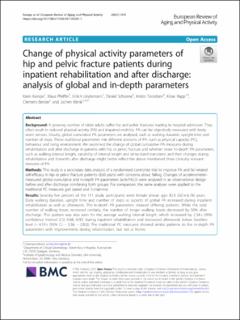| dc.contributor.author | Kampe, Karin | |
| dc.contributor.author | Pfeiffer, Klaus | |
| dc.contributor.author | Lindemann, Ulrich | |
| dc.contributor.author | Schoene, Daniel | |
| dc.contributor.author | Taraldsen, Kristin | |
| dc.contributor.author | Rapp, Kilian | |
| dc.contributor.author | Becker, Clemens | |
| dc.contributor.author | Klenk, Jochen | |
| dc.date.accessioned | 2023-01-19T09:47:44Z | |
| dc.date.available | 2023-01-19T09:47:44Z | |
| dc.date.created | 2021-12-09T15:37:02Z | |
| dc.date.issued | 2021 | |
| dc.identifier.citation | European Review of Aging and Physical Activity. 2021, 18 1-8. | en_US |
| dc.identifier.issn | 1813-7253 | |
| dc.identifier.uri | https://hdl.handle.net/11250/3044520 | |
| dc.description.abstract | Background A growing number of older adults suffer hip and pelvic fractures leading to hospital admission. They often result in reduced physical activity (PA) and impaired mobility. PA can be objectively measured with body-worn sensors. Usually, global cumulative PA parameters are analysed, such as walking duration, upright-time and number of steps. These traditional parameters mix different domains of PA, such as physical capacity (PC), behaviour and living environment. We examined the change of global cumulative PA measures during rehabilitation and after discharge in patients with hip or pelvic fracture and whether more ‘in-depth’ PA parameters, such as walking interval length, variability of interval length and sit-to-stand transitions and their changes during rehabilitation and 3 months after discharge might better reflect the above mentioned three clinically relevant domains of PA. Methods This study is a secondary data analysis of a randomised controlled trial to improve PA and fall-related self-efficacy in hip or pelvic fracture patients (≥60 years) with concerns about falling. Changes of accelerometer-measured global cumulative and in-depth PA parameters (activPAL3) were analysed in an observational design before and after discharge combining both groups. For comparison, the same analyses were applied to the traditional PC measures gait speed and 5-chair-rise. Results Seventy-five percent of the 111 study participants were female (mean age: 82.5 (SD = 6.76) years. Daily walking duration, upright time and number of steps as aspects of global PA increased during inpatient rehabilitation as well as afterwards. The in-depth PA parameters showed differing patterns. While the total number of walking bouts increased similarly, the number of longer walking bouts decreased by 50% after discharge. This pattern was also seen for the average walking interval length, which increased by 2.34 s (95% confidence interval (CI): 0.68; 4.00) during inpatient rehabilitation and decreased afterwards below baseline level (− 4.19 s (95% CI: − 5.56; − 2.82)). The traditional PC measures showed similar patterns to the in-depth PA parameters with improvements during rehabilitation, but not at home. Conclusion Our findings suggest that the in-depth PA parameters add further information to the global cumulative PA parameters. Whereas global cumulative PA parameters improved significantly during inpatient rehabilitation and after discharge, in-depth PA parameters as well as PC did not continuously improve at home. In contrast to global cumulative PA parameters the in-depth parameters seem to reflect contextual factors such as the build environment and aspects of PC, which are traditionally assessed by clinical PC measures. These in combination with digital mobility measures can help clinicians to assess the health status of fragility fracture patients, individually tailor therapy measures and monitor the rehabilitation process. | en_US |
| dc.language.iso | eng | en_US |
| dc.publisher | BioMed Central | en_US |
| dc.rights | Navngivelse 4.0 Internasjonal | * |
| dc.rights.uri | http://creativecommons.org/licenses/by/4.0/deed.no | * |
| dc.title | Change of physical activity parameters of hip and pelvic fracture patients during inpatient rehabilitation and after discharge: analysis of global and in-depth parameters | en_US |
| dc.title.alternative | Change of physical activity parameters of hip and pelvic fracture patients during inpatient rehabilitation and after discharge: analysis of global and in-depth parameters | en_US |
| dc.type | Peer reviewed | en_US |
| dc.type | Journal article | en_US |
| dc.description.version | publishedVersion | en_US |
| dc.source.pagenumber | 1-8 | en_US |
| dc.source.volume | 18 | en_US |
| dc.source.journal | European Review of Aging and Physical Activity | en_US |
| dc.identifier.doi | 10.1186/s11556-021-00261-1 | |
| dc.identifier.cristin | 1966762 | |
| cristin.ispublished | true | |
| cristin.fulltext | original | |
| cristin.qualitycode | 1 | |

